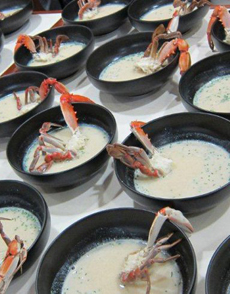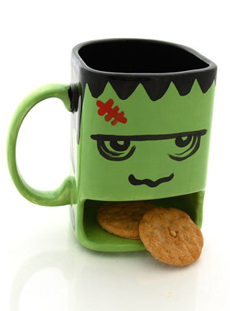|
For entertaining with memorable dishes, serve a chowder, bisque or other seafood soup and garnish it with legs or claws.
If you need extra claws or legs, you can purchase them from your fishmonger. The legs, removed to sell cooked lobster tails, are inexpensive. This easy recipe is a treat for family and guests.
Bisque, chowder…what’s the difference?
Bisque is a thick, rich soup made from fruits, vegetables, game fish or shellfish (particularly crab, lobster and shrimp) and thickened with cream. Popular bisques include chestnut bisque, crab bisque, lobster bisque, squash bisque and tomato bisque. A key difference between a chowder and a bisque is that a bisque is a more elegant recipe, puréed until smooth, and often contains sherry. Chowders also contain pork fat back.
Chowder is most often a soup with fish or seafood as the main ingredient, but there are non-fish chowders such as corn chowder and chicken chowder. Potatoes and other vegetables are typically added and the soup is enriched with salt pork fatback and thickened with flour or crushed soup crackers—two ingredients that define a chowder.
CRAB OR LOBSTER BISQUE RECIPE
You can use fresh cooked, canned or thawed frozen seafood in this recipe.
Ingredients
2 tablespoons unsalted butter
1 teaspoon chopped onion
1 parsley sprig
1-1/2 cups finely chopped cooked crab or lobster meat
2 tablespoons flour
Optional: 1 tablespoon tomato purée*
2 cups chicken stock or canned chicken broth
2 cups half and half or milk
Salt and cayenne pepper
Optional: sherry (cream sherry if you have it) or cognac
Garnish: bits of crab/lobster meat, croutons, crème fraîche/sour cream, crumbled bacon, fresh parsley, grated gruyère cheese
_______________
*The tomato is largely to provide a nice color; so if you don’t have tomato paste, you can omit it.
_______________
Preparation
1. REMOVE half and half from the refrigerator so it will lose its chill prior to use.
2. COOK butter, onion and parsley slowly in a pan until the onion turns yellow. Add the seafood; cook and stir five minutes.
3. STIR in the flour and tomato paste, followed by the chicken stock. Simmer for 20 minutes; then remove the parsley.
4. ADD the half and half; stir. Season with salt, cayenne and sherry/cognac to taste.
5. HEAT but do not boil prior to serving; garnish and serve.
TIP #2: For a smaller soup course, serve the bisque in demitasse or espresso cups.
LOVE SOUP?
Check out the different types of soup—and beautiful soup photos—in our Soup Glossary, along with the history of soup.
Here are different soup garnishes for 20 favorite soups.
Soup cooking tips: 10 tips and tricks for better soup-making.
|
|

[1] The best garnish for a bisque is a solid piece of the seafood it is made from (photo © Mackenzie Ltd).

[2] Lobster bisque garnished with pieces—more readily available than a claw for every bowl (photo © Turner Seafood | Foody Direct).

[3] Waiter, there’s a crab in my soup! Photo © Genji Sushi.

[4] Rich soups like bisque are often served in small portions as a first course. The classic presentation is in a demitasse cup (photo © Hancock Gourmet Lobster).
|








